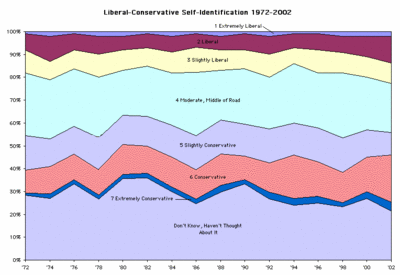These data pertain to survey questions asked of voters during elections from the years 1972 to 2002. The self-identification question, with slight variations in some years, asked respondents "When it comes to politics do you usually think of yourself as extremely liberal, liberal, slightly liberal, moderate or middle of the road, slightly conservative, conservative, extremely conservative, or haven't you thought much about this?" The first chart shows how respondents broke down by each category:

Voters with very strong ideological commitments--identifying as either 'extremely' conservative or liberal--have been and remain fairly small sections of the electorate. More voters recently (especially since 2000) identify as 'conservative,' but the 'liberal' category has seen growth as well.
These trends become more apparent when the liberal and conservative voters are grouped into only two categories, regardless of the strength of their liberal or conservative feelings. (Ignore the numbers after the data labels in the key--they don't refer to the actual category numbers.)

The linear trends of the same data show the changes even more clearly:

Conservatives have increased considerably, but those increases seem not to have come at the expense of liberals. The number of voters identifying as liberal has, in fact, increased, though at a markedly slower rate than increases in conservatives. The greater numbers of conservatives appear to be drawn from the ranks of middle-of-the-road voters and those who hadn't previously thought about their position on the ideological spectrum.
So how is education related to ideological self-identification? These charts break down conservative and liberal voters according to education level:


Conservative voters have increased in all educational categories, though the slope of the increase is steepest for voters who have had some college, but no degree, and those who did not finish high school. Liberals have lost ground among all educational groups except those who did not finish high school, where they show slight gains. Liberal declines have been steepest among those with some college but no degree, yet the slope of those losses is nearly identical to that of losses among college graduates.
Coming next post: data on party identification (as opposed to ideological identification) and education.
No comments:
Post a Comment